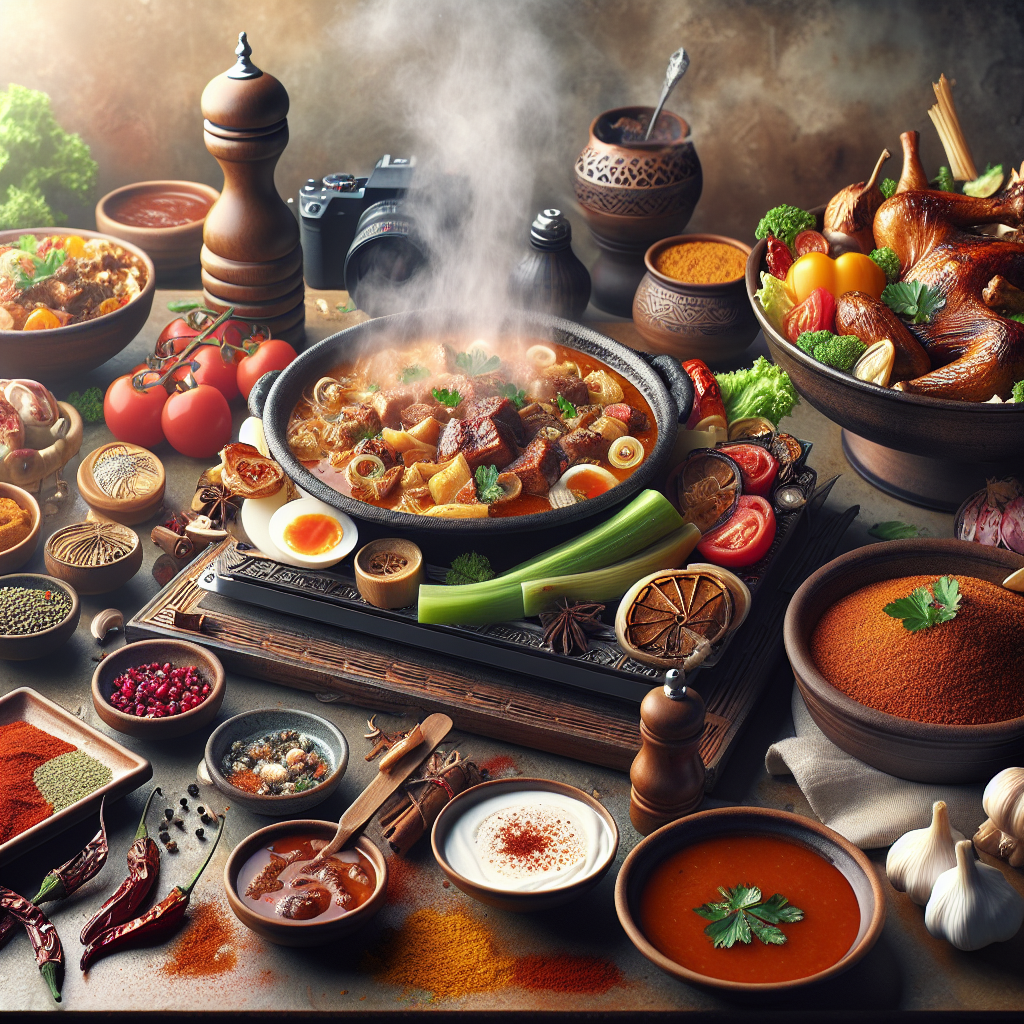Exploring the Rich Tapestry of Turkish Cuisine: A Culinary Journey Through Flavor and Tradition

Welcome to a delightful exploration of the rich tapestry that is Turkish Cuisine. Every bite tells a story, weaving together history, culture, and flavor. As we journey through these remarkable dishes, you’ll discover the warmth of tradition and the joy of shared meals. From aromatic spices to hearty ingredients, the diversity of Turkish Cuisine invites everyone to experience its unique charm. Let’s embark on this culinary adventure together!
Main Points
- Discover the history behind Turkish Cuisine.
- Explore the best Turkish Cuisine dishes and their flavors.
- Learn essential Turkish Cuisine cooking tips for your kitchen.
Delving into the Regional Diversity: How Geography Shapes Turkish Culinary Delights
When one thinks of Turkish cuisine, a vibrant tapestry of flavors, aromas, and textures comes to mind. Indeed, the vast geography of Turkey plays a crucial role in the diversity and richness of its culinary delights. Each region boasts unique ingredients, age-old traditions, and distinct cooking techniques. This article aims to explore how various geographical features have shaped the Turkish Cuisine recipes we cherish today.
The Aegean Coast: Olive Oil and Fresh Ingredients
Along the Aegean coast, the sun-soaked terrain encourages the growth of olive trees, leading to a cuisine that celebrates the lightness of olive oil. A characteristic of this region is the use of fresh vegetables, herbs, and seafood. Dishes like best Turkish Cuisine dishes such as zeytinyağlı enginar (artichokes in olive oil) showcase this vibrant approach. Here, cooking is not merely a task; it’s an art form that reflects the bountiful natural resources available.
Central Anatolia: A Heartier Fare
Traveling inland to Central Anatolia reveals a more robust flavor profile influenced by the region’s harsh winters. This area is known for its grains, particularly wheat, which is transformed into various kinds of bread and pasta. Manti, often dubbed Turkish dumplings, provide a striking example of how local ingredients have been embraced. Interestingly, these dumplings can vary significantly in size and filling across different towns. This regional diversity in Turkish Cuisine cooking tips reveals just how versatile and adaptive this culinary tradition can be.
The Southeast: Spices and Rich Sauces
As one moves toward the southeast, the culinary landscape shifts dramatically. The influences of neighboring regions are palpable here, with spices being a prominent aspect of the cuisine. Dishes abound with layers of flavor, often enhanced by fragrant spices like sumac and cumin. The iconic kebab varieties, particularly Adana and Urfa kebaps, offer a spicy yet tantalizing taste. Understanding these regional specifics can elevate your own cooking, allowing for a genuine experience of Turkish flavors. Embrace the magic of spices, and your journey into Turkish Cuisine recipes will never be dull.
Black Sea Region: A Unique Sea and Land Influence
Lastly, we cannot overlook the Black Sea region, noted for its lush landscapes and abundant fisheries. The use of corn as a staple has led to unique dishes such as cornbread and mısır ekmeği, which are hard to find elsewhere in Turkey. Meanwhile, hamsi (anchovies) prepared in various ways highlights the relationship of geography with the culinary arts. The area’s scenic cliffs and tumbling rivers inspire a cuisine that feels both grounded and inspired. It’s precisely this connection of land and plate that makes Turkish cuisine endlessly fascinating.
In conclusion, Turkey’s diverse landscape plays an integral role in shaping its culinary heritage. Whether through the coastal breezes of the Aegean or the rugged mountains of the East, each dish tells a story, connecting us to the land, the people, and the ingredients. Discovering these best Turkish Cuisine dishes can offer you a taste of the rich history of this beautiful country. So, why not embark on your culinary journey today? With each bite, you’ll be savoring more than just flavors; you’ll be tasting the essence of Turkey itself.
Savoring Tradition: The Influence of Historical Cultures on Modern Turkish Dishes
Turkish cuisine is a vibrant tapestry woven from the threads of history, culture, and tradition. Each dish tells a story, a narrative that transcends time and space. As we dive into the depths of this culinary legacy, we cannot help but appreciate the influence of historical cultures on modern Turkish dishes. This influence is like a rich spice mix that captivates the senses, inviting everyone to explore the layers of flavor and history.
The Ottoman Empire: A Culinary Masterpiece
At the heart of Turkish cuisine lies the stunning impact of the Ottoman Empire. This empire was vast and diverse, encompassing many cultures that contributed unique ingredients and cooking techniques. Imagine a bustling market in Istanbul, filled with the scents of saffron, lamb, and fresh herbs. The Ottomans not only refined local dishes but also embraced flavors from Persia, Central Asia, and the Mediterranean. As a result, we find in modern Turkish dishes a marvelous blend of spices, textures, and cooking methods that are truly mesmerizing.
Tradition Meets Modernity
Today, chefs in Turkey strive to preserve this culinary heritage while also experimenting with contemporary techniques. Picture a traditional meze platter that includes everything from hummus to stuffed grape leaves. However, as modernity creeps in, some culinary experts are adding unexpected ingredients, creating a delightful confusion on the plate. A quirk in this culinary evolution is the emergence of fusion dishes that leave diners both intrigued and delighted. Isn’t it fascinating how a plate of kebabs can be interpreted differently, depending on regional influences and contemporary trends?
Regional Flavors: A Patchwork of Influences
The geographical diversity within Turkey also plays an essential role in shaping its cuisine. From the coastal areas where seafood takes center stage to the heartland where lamb reigns supreme, each region boasts its own unique flavors and cooking practices. Yet, when you look deeper, you realize that these regional dishes often share common threads, akin to distant relatives discovering the family resemblance. The intriguing part is how ingredients that may seem completely different can be interconnected, almost like a culinary family tree that continues to evolve over generations.
Sustaining the Legacy
In our fast-paced world, it’s crucial to appreciate the time-honored traditions that shape our meals. Embracing local ingredients and age-old recipes while giving them a modern twist serves to keep the conversation of Turkish cuisine alive. As you savor each bite, remember that you are partaking in a rich history that connects you to generations past. In essence, modern Turkish dishes stand as a reminder of where we come from while inviting us to dream of where we might go next.
The journey through Turkish cuisine is not merely about food; it’s about culture, love, and the intricate dance of history and modernity. So, the next time you enjoy a bowl of çorba or a plate of manti, take a moment to reflect on the myriad influences that have shaped these dishes into the delightful experiences they are today. Savor the tradition and explore the delightful legacy of flavors that the world of Turkish cuisine has to offer!
Conclusion
As we conclude our exploration, it’s clear that Turkish cuisine holds a unique place in the hearts and palates of many. The rich flavors and diverse dishes reflect a deep cultural heritage that invites exploration and appreciation. Many enjoy gathering around the table, sharing meals that not only satisfy hunger but also create lasting memories. This soulful connection to food showcases the warmth of Turkish hospitality, reminding us of the joy that comes from sharing a meal with loved ones. By embracing and celebrating these culinary traditions, we not only honor the past but also inspire future generations to cherish and continue this beautiful legacy.
Latest Posts
Turkish Döner: The Spinning Taste of Delight
When travelers visit Turkey, one of the first street foods they are...
Galata Tower: The Timeless Icon of Istanbul
Located in the heart of Istanbul, Galata Tower stands as a timeless...
Black Sea Region in Turkey: A Journey Through Nature and Culture
The Black Sea Region in Turkey invites you to explore its stunning...
Journey Through Antalya’s Hidden Gem, Kaş
Discover the enchanting beauty and charm of Antalya's Kaş, a hidden gem...
Echoes of Valor: Exploring the Untold Stories of the Gallipoli Battlefields
The Gallipoli Battlefields echo with stories of bravery and sacrifice, revealing the...
Discover Kuşadası: Top Activities and Hidden Gems to Explore
Discover Kuşadası with its vibrant culture and stunning landscapes. What you can...
Turkish Döner: The Spinning Taste of Delight
When travelers visit Turkey, one of the first street foods they are...
Savoring the Sweet and Savory: The Perfect Duo of Kebap and Baklava
Kebap and Baklava create a delightful culinary experience, blending savory flavors with...
The Sweet Secrets of Turkish Delight: A Journey Through Flavor and Tradition
Turkish Delight, rich in history and flavor, invites us to explore its...
Spices, Sweets, and Savory Delights: The Wonders of Turkish Cuisine
Turkish cuisine offers a rich tapestry of flavors. Spices, sweets, and savory...









